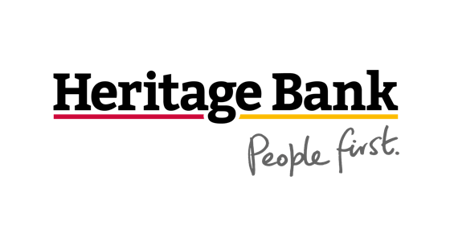
Client:Heritage Bank
Industry:Banking and Financial Services
Region:Asia Pacific & Japan
Heritage Bank: Driving Automation With RPA and AI

98%
The accuracy of Heritage’s most recent machine learning model, built by UiPath, and deployed on AI Center
90%
The level of process automation that Heritage will attain when compiling living expense reports
80
Total processes that have been automated since 2017
Client Overview
Heritage Bank is Australia’s largest mutual bank. The company provides all retail financial products, including home loans through its branch network and through a network of mortgage brokers across every state and territory in Australia.
Heritage Bank is Australia’s largest mutual bank, with 60 branches.
The customer-owned company is also one of Australia’s longest-standing financial institutions. Founded in 1875, Heritage has witnessed countless waves of technological change throughout its long history—from typewriters to the internet and everything in between.
In recent years, however, the company has faced a brand-new challenge: digitalization.
Today, Heritage is dealing with a new class of competitors that includes digitally savvy fintech startups, purely digital “neobanks,” and alternative payment providers. The industry is also seeing increased competition from global financial providers that are attracted to Australia’s strong economy.
Transforming to Meet Digital Demands
Three years ago, David Johnston, (now Intelligent Automation and Process Excellence Manager) who oversees process improvement at Heritage, and his team recognized that they had to modernize their operations to remain competitive—a process that’s easier said than done in the highly regulated world of finance.
“Heritage is transforming from a physical bank with a digital presence to a digital bank with a physical presence,” Johnston explains. “We’re still growing our branch network and see it as an important part of our business. But we’re also growing digitally so that we can interact with customers wherever they are.”
Like all companies, Heritage has experienced some growing pains.
Growing companies need to scale across several different areas,” Johnston said. “For example, you have to account for member growth as well as growth in payments which can create operational issues. We discovered that we needed to digitalize or build scalability into our back office and middle office processes and provide efficiency to our customer service staff so they can deal with the increasing scale of our membership base.
Johnston touched on two important issues here—the customer experience (CX) and employee experience (EX)—both of which are major priorities for most companies.
These initiatives involve optimizing internal processes to attract and retain customers and employees and both are extremely important in the ultra-competitive finance industry. Customers after all, expect seamless experiences across all touchpoints. At the same time, employees want to work for employers who are on the leading edge of technology.
By today’s standards, automation, artificial intelligence, and machine learning are at the forefront of scientific progress and innovation. Yet while demand is surging for automation and intelligence, many businesses are struggling to implement them into their workflows—something that Heritage encountered when they started looking into automation.
To streamline automation development and implementation, Heritage was approached by a consultant about a new solution called robotic processing automation (RPA), which involves using software to automate repeatable business process tasks like discovering patterns, sorting through data, and populating customer relationship management (CRM) databases with relevant information to drive sales.
Johnston admits that he was skeptical at first. But when he saw the true power of what RPA can offer for an organization, he was sold on the technology.
Solution: UiPath’s RPA Platform
After reviewing multiple leading providers in a Forrester Wave report, Heritage looked into UiPath, a company that simplifies digital transformation by rapidly automating processes.
According to Johnston, UiPath helped guide the team along every step of the way, providing assistance and helping explain how RPA works.
Since starting with UiPath in 2017, Heritage has successfully automated about 80 customer-facing, back-office, and middle-office processes. These processes are spread across operations, payments, financial crimes, and contact center services, among other areas.
Johnston now has a small team of full-time RPA developers working in the company’s centralized RPA Center of Excellence (CoE), with a number of business champions across the bank. Together, they are training bots to learn business processes—and then automate them.
“These bots are entering information into the core banking system around fraud alerts,” Johnston explains. “They're putting notes into our customer relationship management systems around payments or transfers that processed with addresses that changed and a whole bunch of other things. Our robots even post about promotions, anniversaries, and birthdays on our corporate intranet."
So, realistically, everyone at Heritage knows all the robots and sees them doing things. There wouldn’t be a person at Heritage going through their lives without being touched on by UiPath.
It was only recently, though, that Heritage incorporated AI into their workflows.
How Heritage Found AI and AI Center
Here is a breakdown of how Heritage identified their first AI use case.
Financial Crime Reporting
Heritage’s journey to AI began with an RPA use case.
Heritage’s financial crimes team occasionally works with law enforcement to produce transaction records and other data—a process that can be very time-consuming when having to pull data manually from core banking systems, CRM systems, and other applications.
Using UiPath, Heritage was able to create a bot that could understand input instructions (e.g. time, date, location, and type of transaction), and pull data from multiple systems to compile police reports—saving countless hours of tedious labor.
“The financial crimes use case was very successful,” Johnston says. “These requests come through sporadically and are dealt with by the bots and the process is very scalable.”
Shortly after this project, the team received another request to improve living expense report management for loans. So, they tried to replicate their financial crimes deployment.
Living Expense Reports
Financial institutions were facing increased pressure from regulators to do a better job of investigating living expenses when assessing loans. As with their previous use case, this process involved pulling data manually from multiple sources.
Once again, Johnston’s team needed to find a way to sift through large volumes of data from different areas, locate specific types of transactions, and quickly classify them. So, the team built automated rules that could pick up keywords and classify specific transactions. At the time, this system was capable of classifying roughly 40 to 50 percent of transactions—meaning there was still a large amount of manual work involved.
At this point, the Heritage team was faced with a true machine learning challenge. The team needed to find a way to classify transactions on a much larger scale than they were familiar with. The UiPath team was asked to intervene and stepped in to help build and test a custom machine learning model. This is when AI came into the picture for Heritage, as UiPath utilized its AI Center platform.
AI Center is a tool that allows data science and RPA teams to instantly apply AI to RPA workflows using drag-and-drop functionality, proprietary and custom models, end-to-end visibility across model versioning and updates, performance updates, and more.
For Heritage, the results have been spectacular. With the help of AI Center and UiPath’s custom model, Heritage is on track to automate around 90 percent of the data mining transactions when generating living expense reports.
“Twelve months ago, that process was adding an hour of human effort to every loan application,Johnston says.
We're doing roughly 1,000 online applications—with less than half of those coming from existing customers. So, 500 loan applications coming through the pipeline would require 500 hours of manual labor. This was creating a significant delay in the loan application process.
David Johnston • Intelligent Automation and Process Excellence Manager at Heritage Bank
Now, financial employees are free to work on more loans thanks to UiPath. In addition, the loan application process is much faster—which has, in turn, improved CX and EX at Heritage.
Other Potential AI Use Cases
Johnston identified additional opportunities beyond financial crimes and living expense assessments that his team could explore. They include:
Automating verification. Validating return documents is very time-intensive. AI could be used to classify documents and streamline this process.
Customer management. According to Johnston, there’s a lot of opportunity to improve data quality. For example, a provider could benefit by identifying customer movement patterns and determining who has moved and why.
Customer service. Companies could use AI to create next best offers, empowering agents to be more effective during calls. By using AI Center, it’s possible to pull a model, collect data, and rapidly go back to the contact center agent with the information, through an attended bot while the agent is engaging with the customer.
Common Roadblocks to Expect when Automating with AI
As someone who is heavily immersed in RPA and AI, Johnston was able to offer some sage advice for financial companies considering automation by explaining how to overcome roadblocks.
1. Contention for capital
Oftentimes, companies simply lack the money to invest in automation and intelligence.
“One challenge that’s unique to mutuals is contention for capital,” Johnston explains. “In mutuals, our only way of growing tier one capital is through retained earnings. This heightened the need to automate in a cost-effective and efficient way. Ultimately, every dollar we invest in technology is money that we can’t invest in growing the loan book of the bank. So, we need to balance investment and growth more tightly than most other organizations.”
2. Finding top talent
The types of data analysis that most financial companies are looking to use today require skill sets that go beyond those of the average developer. They require expert engineers and data scientists, both of which are difficult to attract and expensive to hire and retain. As such, there is currently a massive global skills shortage in data science, automation, and artificial intelligence—making it hard to implement automation at scale.
3. Organizational structure
At most companies, data science and RPA automation teams operate independently from one another. This makes it difficult to bring people together to collaborate on projects.
“Data science and automation teams are often disconnected,” Johnston says. “In our organization, however, both of those teams report to our CFO which in some ways is a bit rare. We have data and automation teams working in IT, finance, and operations. They could be a strategy of other functions within the business as well. So, getting together is challenging, but bringing these two teams together to work on the same problem together isn't something that we've had to think too much about. From an automation perspective, there's been plenty of low-hanging, relatively simple, rules-based processes to go after that would keep most organizations really busy for at least a few years.”
4. Executing ML models
AI Center, as a machine learning model delivery system, puts machine learning models into use and helps extract business value. The alternative solution is typically very complex, expensive, and requires installing third-party software.
This is one of the biggest roadblocks that enterprises face when implementing and scaling AI. Data scientists typically spend about 25 percent of their time deploying models—time that could otherwise be spent understanding use cases and building models.
Rethinking Automation
Johnston and his team members at Heritage are very pleased with UiPath’s solutions. According to Johnston, AI Center, in particular, is very approachable; it’s flexible and you can use it for any type of automation.
By the numbers
98% The accuracy of Heritage’s most recent machine learning model, built by UiPath, and deployed on AI Center
90% The level of process automation that Heritage will attain when compiling living expense reports
80 Total processes that have been automated since 2017
UiPath, it should be noted, is technically classified as a hyperautomation company by Gartner—an area of focus that Gartner named a top 10 strategic technology trend for 2020. In other words, UiPath combines multiple process automation components that make it possible to automate work.
UiPath offers a diverse portfolio of AI solutions, which allows customers to automate more processes. For example, UiPath offers solutions for document understanding, computer vision, and process understanding.
“The reality is that as soon as you start investigating RPA, you’ll find that the opportunities are so huge and integration problems are typically so large, that automation is actually a very strategic platform for growth,” he says.
And when you start to use AI in the various ways that UiPath offers, it really broadens the type of process that you can go after from an automation perspective.
David Johnston • Intelligent Automation and Process Excellence Manager at Heritage Bank
RPA teams should think more broadly about the kinds of opportunities that they can leverage by combining AI and RPA, Johnston continues. At the same time, more companies need to embrace the idea of automation driven digital transformation.
“We need to increase and nurture automation and data science skills,” Johnston says. “There’s a broad, organizational shift in mindset that needs to start happening.”
Tip: Focus on Delivery for Success
At the same time, Johnston says, it’s important to think beyond discussions about AI governance. Executives and administrators need to see more practical results for the technology to proliferate.
It’s important to keep delivering solutions so that it becomes less of a conversation about AI governance and more about the delivery of AI.
David Johnston • Intelligent Automation and Process Excellence Manager at Heritage Bank
In one study, roughly 20 percent of companies said they were expecting to deploy AI at scale. In 2019, only about 4 percent of companies said they plan to deploy AI across their enterprise—and many are stuck in pilot stags. This is largely because companies believe they need to focus on understanding the fundamentals of AI before expanding their projects. As a result, many companies are spinning their wheels and failing to drive results.
For the best results, companies should consider starting with a single use case, learning the fundamentals and business impact of that particular process, and then rolling that process out to other use cases in a methodical manner.
In digital transformation, this is called a “lighthouse” project. The concept is to experiment with a new technology, and then deploy “lighthouses” strategically in different settings.
What Will You Automate?
As you can see, AI-powered automation is not out of reach for the average organization—even for a company like a traditional retail bank operating in a tightly regulated and highly competitive sector.
This begs the question: What can your company automate with UiPath?Learn more about UiPath AI capabilities here or contact sales to find out details about AI Center features and pricing.
Related case studies
Ready for your own case study?
Speak to our team of knowledgeable experts and learn how you can benefit from agentic automation.






